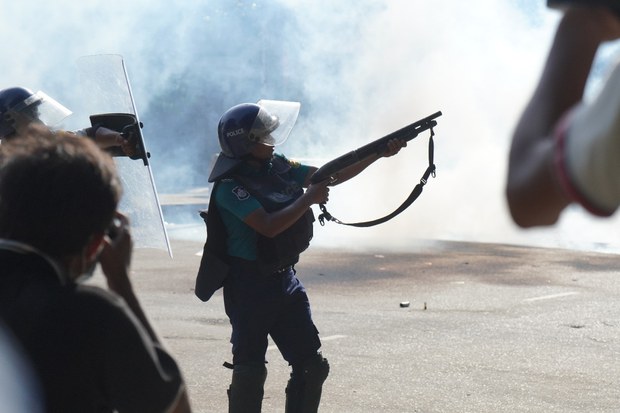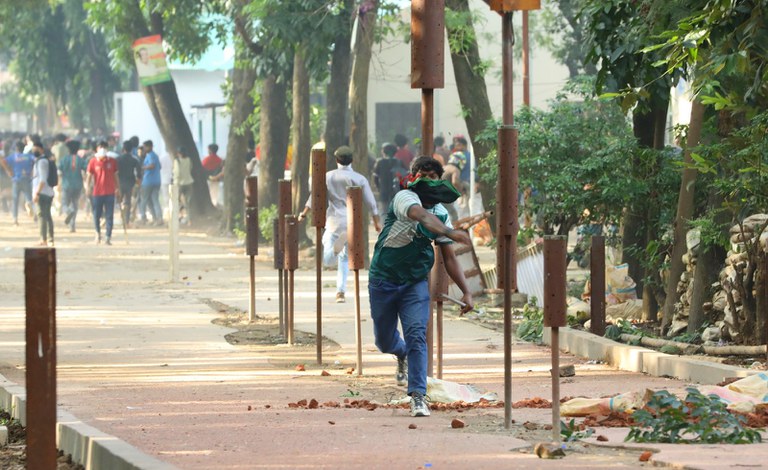Bangladesh student protests are more than about reducing public service job quotas
2024.07.17
 A policeman points a weapon at a funeral procession held at Dhaka University campus for students who lost their lives in the quota protests, Dhaka, July 17, 2024.
A policeman points a weapon at a funeral procession held at Dhaka University campus for students who lost their lives in the quota protests, Dhaka, July 17, 2024.
Bangladesh has been engulfed by mass student protests demanding a reduction in the high quotas set for public service jobs.
The nationwide agitation opposing the government’s defense of 30% quotas for the descendants of the country’s independence war heroes has claimed at least six lives and injured nearly a thousand people over the past two days.
Students demanding quota reforms were victims of attacks by elements from the Bangladesh Student League, which is affiliated with the ruling Awami League. The police have also used indiscriminate and lethal force on demonstrators.
The situation became so dangerous that the government ordered all educational institutions to close indefinitely, slowed internet speeds and deployed Border Guard Bangladesh forces in the capital Dhaka and other large cities to quell the unrest.
The sudden, dramatic and grim turn of events over the past two days after relatively peaceful demonstrations last week call into question the reasons behind the rapid spread of the student movement and the government’s aggressive response.
An understanding of the quotas and their progression, as well as the political context of the last 15 years of the Awami League administration would help shed light on what is the first major and direct challenge against Prime Minister Sheikh Hasina.
Sure, on the face of it, the protests are against public service job quotas.
But what students are really venting their frustrations at are the lack of employment opportunities, the thuggish behavior of members of the ruling party and its student wing, corruption at high places, and three consecutive stage-managed elections, all of which have led to a general sense of political disenfranchisement.
Why protests?
A total of 56% of government jobs are reserved for various sections of society in Bangladesh.
Of this total, second- and third-generation descendants of those who fought in the 1971 war of independence get 30% of civil service jobs. Women and people from underdeveloped districts get 10% each of seats, indigenous communities are allocated 5% reserves and differently abled 1%.
The movement for reforming the quota system first gained momentum in early 2018, with protesters back then – and now – alleging that quotas were discriminatory and benefitted only those who supported Hasina and her party.
Back then, the Hasina government used its party’s henchmen to intimidate, harass and attack demonstrators. Many protesters were also thrown in jail. But they didn’t back down.
In April of 2018, Hasina gave in and abolished the quota system entirely.
There had been no quotas since, until the High Court on June 5 this year ruled the 2018 abolishment null and void, effectively reinstating the system. The judgement was made on a writ petition filed in 2021 by seven descendants of independence war veterans.
The reinstatement annoyed students who began peaceful protests on July 1.

Hoping for a reprieve, a July 11 Supreme Court order suspended these government service job quotas for a month. But that didn’t mollify the protesting students, because they believed any decision on the issue must be made by the executive so it is not questioned.
But what really made the protesters erupt in fury was Hasina on Sunday implying that those against quotas for independence heroes’ descendants are demeaning the war veterans and therefore are akin to “razakars.”
People who collaborated with what is now the country of Pakistan during Bangladesh’s 1971 war of independence are called “razakars.”
Protesting students saw Hasina’s comments as denigrating their movement and demanded she withdraw her comments.
Awami League officials found the demand “audacious,” as party Secretary General Obaidul Qader put it on Monday. The party’s student wing Bangladesh Student League was “prepared to give an appropriate reply” to the anti-quota protesters, he said at a press conference Monday.
A day later, as students at various campuses began demonstrating, members of the Bangladesh Student League and police let all hell break loose.
At least six people were killed by the end of that day.
It is worth asking why thousands of students would protest for about 3,000 civil services jobs available annually.
Additionally, consider this: The widespread participation of students in this movement, while supported by the opposition was not started or encouraged by it.
This anti-government movement is really an outburst of social, economic and political discontent that has been simmering for years.
On the social front, for more than a decade, ruling party-affiliated students have reigned over university campuses, turning dormitories into recruitment centers for the Awami League, or coercing those who lived there to join the ruling party.
These elements from the Awami League’s student wing enjoy impunity for their violent transgressions, as university administrators look the other way to curry favor with the party’s politicians.
Protesting students see the current movement as a way to regain their dignity.

On the economic front, university students who will soon be in the job market see few employment opportunities despite the government claiming it has achieved significant growth.
A 2023 Bangladesh Bureau of Statistics (BBS) survey found that more than 39% of 15- 24-year-olds don’t have jobs and are not studying either. That translates to about 12.2 million people.
The government’s claim that the unemployment rate is 3.3% – or 2.35 million jobless – is contested by several noted economists.
In fact, over the past decade, the economy has failed to create enough jobs for the 2 million people who enter the job market annually.
Further, cronies of the government are plundering millions of dollars from Bangladesh, which they are stashing abroad.
Recent reports alleging that a former Army chief Gen. Aziz Ahmed, ex-police chief, tax officials and even the personal assistant to the prime minister were under the scanner for corruption show that a kleptocratic system has not just emerged but flourished under the Hasina regime.
And without the opportunity to vote in a free and fair election in January – the opposition boycotted the exercise – those who are demonstrating on the streets are also feeling politically disenfranchised. Many of them had become eligible to vote for the first time for this year’s election.
They already felt left out by the government’s legal and extralegal restrictions on freedom of expression, and curbs on content online.
Aggressive response
What makes the current mass student protests noteworthy is a perfect storm of circumstances for the Hasina administration.
The government has been unable to stem dwindling foreign reserves or contain spiraling inflation. And it is unnerved by the United States in May sanctioning the ex-army chief Aziz Ahmed for “significant corruption” and barring him and his family from entering the U.S.
The Hasina administration fears spontaneous grassroots anti-government movements such as the ones that took place in neighboring Sri Lanka in 2022 and Pakistan in 2022-2023.
And most frightening for the ruling Awami League has been what is the first direct and open challenge to Hasina since the beginning of her three consecutive term reign in January 2009. People had criticized her party and the administration in general, but challenging the PM’s statements had been taboo.
Because Hasina’s government doesn’t have the popular mandate, it has very few instruments in its toolbox to face off challenges to its power – except the use of force.
That, though, will only make a bad situation for Hasina worse. Other sections of society that have been struggling economically since the COVID-19 pandemic and the non-stop inflation since may decide to join the protesting students.
That would be a truly mass uprising.
Ali Riaz is a distinguished professor of political science at Illinois State University and a non-resident senior fellow of the Atlantic Council. The views expressed here are his own and do not reflect the position of Illinois State University, the Atlantic Council, or BenarNews.







